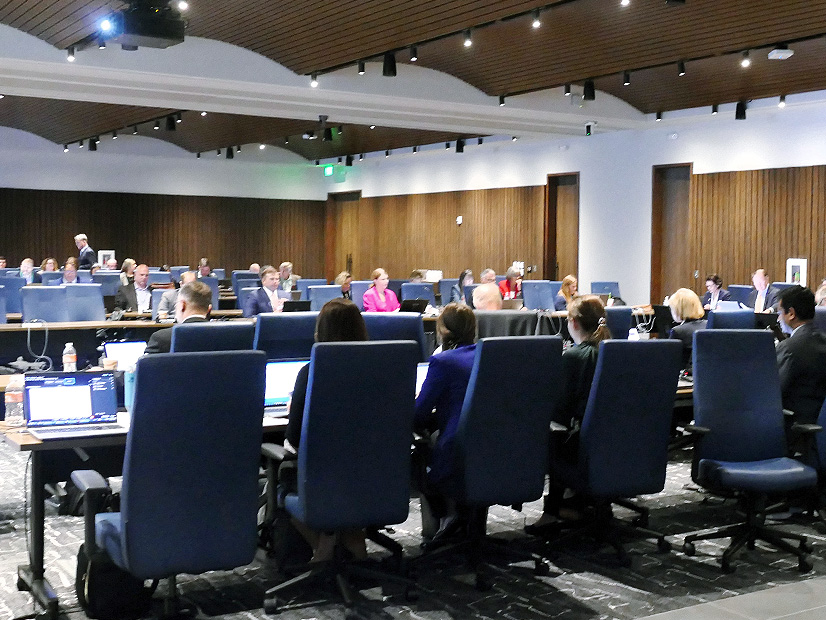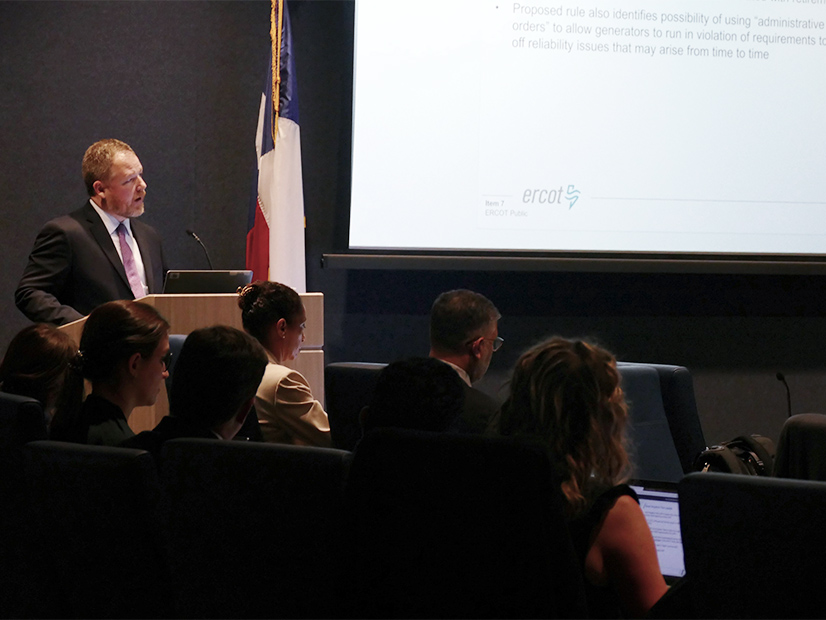AUSTIN, Texas — ERCOT said last week it is reviewing the electric-industry-related legislation that passed during the Texas Legislature’s recently completed biennial session to determine what changes are required and their effect on grid operations.
CEO Pablo Vegas told the Board of Directors Tuesday that the legislative session was “intense” given the number of electric-related bills that were taken up and the “disparate opinions on how to address really the core issues of market redesign.” He promised a full report in September.
The 88th Legislature saw 257 bills filed touching on energy, ERCOT or the Public Utility Commission. Two years ago, after the deadly 2021 winter storm that nearly took out the Texas grid, legislators filed 311 bills. In the four sessions before Winter Storm Uri, an average of 100 similar bills were filed.
“Our team is currently working on analyzing the effect of all the provisions that have passed in the legislature,” Vegas said. “We will be communicating more as we assess along with the [PUC] the best approach for complying with the new changes in legislation.”
A sunset bill (House Bill 1500) that maintains operations at ERCOT, the PUC and the Office of Public Utility for another six years included several market redesign elements. Chief among those were several provisions adding guardrails to the PUC’s proposed performance credit mechanism (PCM) that rewards generators with credits for reliable performance during a predetermined number of scarcity hours. (See Texas PUC Submits Reliability Plan to Legislature.)
The measure caps the net cost to the ERCOT market at $1 billion (less the cost of bridge solutions), adds penalties for generators that don’t meet performance obligations and requires that bridge solutions to the PCM be rolled back.
HB1500 also requires ERCOT to add an uncertainty ancillary service product called dispatchable reliability reserve service (DRRS). Based on historical variations in availability for each season, the DRRS’ criteria require participants to be online and dispatchable for less than two hours after being deployed and to run for at least four hours. The intent is to reduce ERCOT’s reliance on reliability unit commitments, which have soared under the grid operator’s conservative operations posture.
The ISO could also have to deal with Senate Bill 2627, which creates a low-interest loan program with $5 billion set aside by lawmakers for primarily new gas generation in ERCOT. Loans and completion bonuses would be disbursed through the Texas Energy Fund, which must first be approved by voters in November.
Board OKs 27% Increase in Admin Fee
The board accepted the Finance and Audit Committee’s recommendations to increase ERCOT’s system administration fee for the first time since 2016 and to approve the 2024-25 biennial budget.
The admin fee will be raised from $0.555/MWh to $0.710/MWh, a 27.9% increase. Much of that difference will be passed on by retailers to ratepayers. Consumer advocates don’t oppose the increase, saying it was long overdue and will help pay for the real-time co-optimization (RTC) project that is expected to save billions.
The budget will provide ERCOT with $424.03 million and $426.99 million in 2024 and 2025, respectively, for operating expenses, project spending and debt service obligations.
Both measures will be filed with the PUC for its approval.
According to a 2018 Independent Market Monitor report, the market tool would result in a $1.6 billion reduction in annual total energy costs, or about a $4/MWh price reduction. The report also found reliability would be improved by reduced overloading of transmission constraints and less use of the regulation-up ancillary service equating to $4.3 million. Another $400 million would have been saved by reducing congestion costs and ancillary service costs.
Staff told the Reliability and Markets (R&M) Committee June 19 that it will cost about $50 million to complete the RTC project, which was put on hold after the 2021 winter storm. They said RTC’s complex implementation has made it difficult to find the timing and resources for delivery, but that they are ready to resume work on July 1 with an eye on completing the project in 2026.
Most other grid operators already use the RTC tool, which dispatches energy and ancillary services every five minutes. ERCOT says RTC will produce energy from cheaper resources, with more expensive resources shifting to the ancillary market.
In discussing ERCOT’s technology stack with the R&M, Vegas said RTC and the PCM, “potentially,” are among the near-term major projects.
New Ancillary Service Deployed
Staff told the board that the ISO has added and deployed in June its first ancillary service in more than 20 years with ERCOT contingency reserve service (ECRS). The product provides the system with additional capacity that can ramp in 10 minutes to respond to short-term net load ramps.
Vegas said ECRS is necessary because load and generation are constantly changing because of daily load patterns and instantaneous load variation, changes in variable generation and units tripping offline.
ECRS procurements began June 10 with “minimal hiccups,” Vegas said. It was first deployed June 14, and then again June 16 and 18 for between five and 25 minutes in amounts between 200 and 600 MW. ERCOT procures about 2 GW of ECRS per hour at an average price of $25.26/MWh.
“It’s working exactly as we had hoped,” Vegas said. “It’s become a new tool in our suite of operational flexibility products. We’ve got a broader suite of tools now that we can use to help deal with changes in load changes in supply and to be able to respond very quickly to market conditions as they evolve.”
ERCOT Mulling Coming EPA Regs
ERCOT general counsel Chad Seely briefed the board on EPA’s Good Neighbor Plan, which requires nitrogen oxide emission reductions from power plants and industrial facilities, and four other pending regulations that could affect the state’s dispatchable resources.
Texas is among 23 states that, under the plan, must meet the Clean Air Act’s “good neighbor” requirements by reducing pollution that contributes to problems attaining and maintaining EPA’s health-based air quality standard for ground-level ozone in downwind states. (See EPA Good Neighbor Plan Expected to Accelerate Coal Plant Retirements.)
The plan was to be effective Aug. 4. Texas, after earlier being granted a stay of EPA’s disapproval of its state implementation plan by the 5th U.S. Circuit Court of Appeals, filed a lawsuit June 7 with the same court that challenges the good neighbor plan.
“The EPA right now is coming out with a lot of rules over the near-term and long-term could have a significant impact on our dispatchable resources,” Seely told the board.
He said EPA’s most significant rule is the proposed greenhouse gas rule that would require new carbon dioxide restrictions for some coal and gas units by 2030. Several parties have asked for an extension of the Aug. 4 comment deadline; Seely said he expects EPA to grant that request.
In the meantime, ERCOT is evaluating the reliability effect on the thermal generation fleet. Seely said the ISO is collaborating with the PUC, the Attorney General’s office, and the Texas Commission on Environmental Quality.
“But most importantly, we have to engage the generators to understand what the direct impact is,” Seely said. “They were very instrumental in giving us feedback that ultimately rolled into our assessments … so it’s critically important as we continue to move forward and evaluate these regulations that we have the partnership with the generators to continue to work with ERCOT. They are really in the best position to tell us what that overall impact is.”
Seely reminded the board and stakeholders that the greenhouse rule is still in the formal rulemaking process. He said while the final outcome is unknown, he does not see any obstacles “in the path of any generation facility.”
“We don’t know what challenges may occur” when the final rule is published, he said. “I assume every investor is looking at what the potential environmental restrictions will be going forward with these proposals.”
“If you’re an investor thinking about putting capital into a project like this, a rule like this causes regulatory uncertainty,” cautioned board Vice Chair Bill Flores. “I think it will be exceptionally damaging to potential construction of possible units. This is scary.”
Other proposed EPA regulations include:
- The Texas Regional Haze Federal Implementation Plan that would establish new limits on sulfur dioxide and particulate matter emissions for a dozen primarily coal-fired generating units;
- Revisions to the Mercury and Air Toxics Standards Rule that further restrict mercury and “filterable particulate matter” emissions from coal- and oil-fired generating units; and
- A tailpipe rule that would further reduce greenhouse gas and other emissions from light, medium and heavy-duty vehicles.
Directors Approve 12 Rule Changes
The board unanimously approved 12 protocol and guide changes. Three measures, with dissenting votes during the stakeholder process, were approved separately, including a nodal protocol revision request (NPRR1169) that expands the qualifications for generation resource that may be a firm-fuel supply service (FFSS) resource or an alternate.
The Technical Advisory Committee approved NPRR1169 in May but took it up again during a special June 6 call after the PUC called for additional discussion. (See ERCOT TAC Endorses Agreement on ‘Exceptional’ Fuel Costs.)
The R&M approved the measure after adding ERCOT comments that define an FFSS qualifying pipeline as one excluding intrastate gas utility pipelines that serve customers with a higher protection under the Texas Railroad Commission’s curtailment rule than electric generation facilities. The rule assigns a higher priority to human needs customers and local distribution systems that serve human needs customers.
The directors approved seven other NPRRs, two revisions to the nodal operating guide (NOGRRs) and single changes to the retail market guide (RMGRR) and the verifiable cost manual:
- NPRR1143: allows ERCOT to give charging instructions to energy storage resources during a Level 3 energy emergency alert.
- NPRR1161, NOGRR246: clarifies that intermittent renewable resources that remain synchronized to ERCOT, but are unable to provide reactive power when not providing real power, do not have to notify ERCOT other than their real-time telemetered status.
- NPRR1166: changes the expiration date for DC ties’ schedule information protected status from 60 days after the applicable operating day to the date on which ERCOT files the report with the PUC, as required by transmission export rates’ rules related to energy imports and exports over the ties.
- NPRR1167: improves the new FFSS product by removing language disqualifying or decertifying resources from the firm-fuel program.
- NPRR1168: changes the Texas standard electronic transaction (Texas SET) to “Establish/Change/Delete CSA Request” and adds new sections to the protocols related to administering requests to change end dates for active continuous service agreements (CSAs).
- NPRR1177: requires resources to file exceptional fuel costs that include contractual and pipeline-mandated costs, following negotiations between consumer representatives and a generator.
- NPRR1178: clarifies and updates expectations for resources providing ECRS.
- NOGRR253: aligns the guide’s language regarding ECRS and nonspin with NPRR1178’s proposed revisions and NPRR1096’s proposed protocol language. The NOGRR would also clarify that ERCOT may manually deploy load resources, other than controllable load resources that are providing ECRS or responsive reserve, to maintain a minimum 500 MW of physical responsive capability reserves on dispatchable resources to balance demand with supply while maintaining stable grid frequency for smaller disturbances.
- RMGRR172: updates the Texas SET transaction’s name to “Establish/Change/Delete CSA Request” and adds new sections to the guide that describe how to cancel a pending CSA through MarkeTrak.
- VCMRR031: defines variable costs and clarifies that all cost components used to calculate a filing entity’s fuel adder should also be based on variable costs; removes the minimum requirements fee cost category from being included in the fuel adder; and changes the review timeline to give ERCOT the ability to follow up on more complex cost submissions.
— Tom Kleckner





